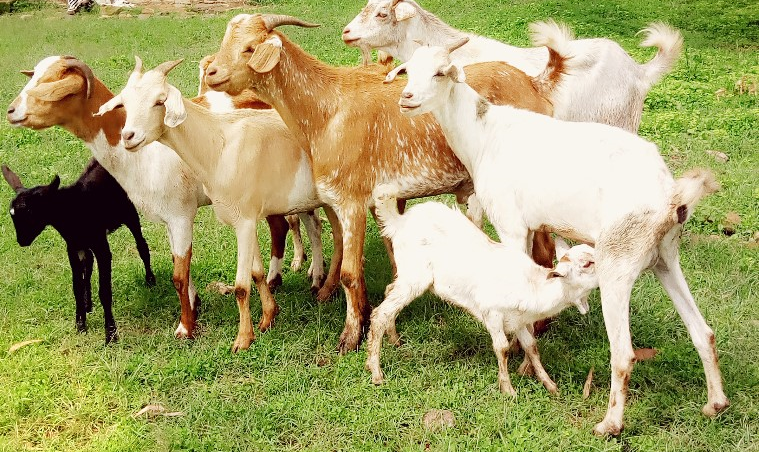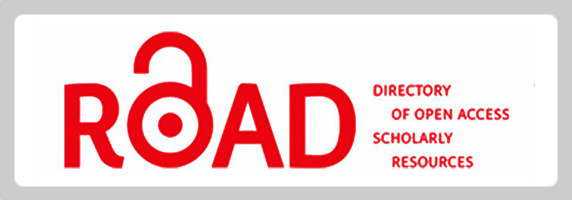Describing the Traditional Breeding Practices for Improvement of Genetics of Indigenous Goat Populations in South Gondar, Ethiopia
Abstract
The study was conducted to describe the breeding objectives, selection criteria, and breeding practices for improvement of genetics of indigenous goat populations in South Gondar. To this effect, 3 districts (Farta, Fogera, and Libokemkem) were selected purposely based on distribution of goat population. Data were collected from 153 randomly selected households and gathered through semi-structured questionnaires, focus group discussions, and field observations. The results indicated that the overall mean of young bucks and does was 7.9% and 10.5%, respectively. The mean number of breeding does per household was 4.55, 5.12, and 5.8 in Farta, Fogera, and Libo-kemkem districts, respectively. The average flock size per household for Fogera, Farta, and Libokemkem was 9.2, 10.5, and 11.7 with an overall average of 10.5 goats. Income generation, meat consumption, and saving ranked first, second, and third, respectively for the reason of goat rearing in all districts. About 62.7 % of the respondents owned breeding bucks of which 70.8 % of them were born in the flock. The overall selection criteria of bucks were early maturity, coat color, and appearance with index values of 0.22, 0.2, and 0.19, respectively. Selection criteria of does were appearance, sexual maturity, and litter size with index values of 0.2, 0.19, and 0.14, respectively. About 95% of the households exercise uncontrolled mating. The results concluded that breeding does in south Gondar represented the largest proportion of goats and covered 49.8% of the total population of goats followed by kids of both sexes. Goat breeding practiced in the study area was traditional, keeping them primarily for income generation. The breeding system of the goat was characterized by uncontrolled mating which would lead to the occurrence of inbreeding depression in small flocks.
Downloads
References
Abegaze S (2014) Design of community based breeding programs for two indigenous goat breeds of Ethiopia Doctoral Thesis,Vienna, Austria. https://cgspace.cgiar.org/bitstream/handle/10568/53927/Thesis_SolomonAbegaz.pdf;sequence=1
Abraham H, Gizaw S and Urge M (2017) Begait goat production systems and breeding practices in Western Tigray, North Ethiopia. Open Journal of Animal Sciences, 7(2): 198-212 (https://www.scirp.org/journal/paperinformation.aspx?paperid=75753)
Alemu A (2015) On-farm phenotypic characterizations and performance evaluation of Abergelle and Central highland goat breeds as an input for designing community-based breeding program. M.Sc. Thesis. Haramaya University, Haramaya, Ethiopia. (https://core.ac.uk/download/pdf/132667081.pdf )
Armstrong JB (2006) Inbreeding: why we will not do it? (http:/www.parispoodles.com/inbreeding.html)
Asefa B, Kebede K and Effa K (2015) Assessment of production and reproduction system of indigenous goat types in Bale Zone, Oromia, Ethiopia. Academia Journal of Agricultural Research, 3(12): 348-360. (https://www.academiapublishing.org/journals/ajar/abstract/2015/Dec/Asefa%20et%20al.htm)
Befikadu Z and Kiflay W (2015) Reproductive performance and breeding strategies for genetic improvement of goat in Ethiopia: a review. Greener Journal Agricultural Science 5, 023-33. https://zenodo.org/record/3380634#.YHgyZ-5KjIU
Bireda W, Sheriff O and Ayalew H (2018) Characterization of the indigenous goat production system in Asossa zone, Benishangul Gumuz region, Ethiopia. Africa Journal of Food Agricultural Nutrition 18(3). https://www.researchgate.net/publication/329948798
CSA (Central Statistical Agency) (2018) Federal democratic republic of Ethiopia Central statistical agency Agricultural sample survey. Volume II: Report on livestock and livestock characteristics.
Dea D, Melesse A and Mekasha Y (2019) Application of morphometric traits and body indices in assessing the type and function of local goats reared in two districts of Gamo-Gofa Zone, South Ethiopia. Ethiopian Journal of Animal Production, 19 (1): 73-90.
Derib G (2017) Production and marketing systems of goat in Hamer woreda,South Omo zone, Southern Ethiopia. M.Sc. Thesis. Arbaminch University. Arbaminch, Ethiopia. file:///C:/Users/ad/Downloads/GEBEYEHUlastReport.pdf
Falconer D S and Mackay T F C (1996) Introduction to quantitative genetics 4thEdn, Harlow, England, Longman. 438.
Fantahun T, Alemayehu K and Abegaz S (2016) Characterization of goat production systems and trait preferences of goat keepers in Bench Maji zone, south western Ethiopia. African Journal of Agricultural Research, 11(30): 2768-2774.
FAO (2004) Livestock sector brief: Ethiopia. Food and Agricultural Organization of the United Nations. Livestock Information, sector Analysis and Policy Branch. FAO, Rome.
Gatew H, Hassen H, Kebed, K and Haile A (2015) Characterization of indigenous goat po,pulations in selected areas of Ethiopia. American-Eurasian. Journal of Scientific Research, 10 (5): 287-298, ISSN 1818-6785.
Gebreyesus G, Haile A and Dessie T (2012) Participatory characterization of the Short-eared Somali goat and its production environment around Dire Dawa, Ethiopia. Livestock Research for Rural Development, 24(10).
Gizaw S, Tegegne A, Gebremedhin B and Hoekstra D (2010) Sheep and goat production and marketing systems in Ethiopia: Characteristics and strategies for improvement. IPMS (Improving Productivity and Market Success) of Ethiopian Farmers Project Working Paper 23. ILRI (International Livestock Research Institute). Nairobi, Kenya. pp, 1-61.
Hagos G, Kebede K, Banerjee A K and Wolde Z (2016) On-Farm phenotypic characterization of begait goat and their production system in Western zone of Tigray, Ethiopia. International Journal of Research and Innovations in Earth Science, 3(1), 2394-1375.
Hirpa A and Abebe G (2008) Economic significance of sheep and goat. pp 1-4. In: Alemu Yami and R.C. Merkel(eds.). Sheep and goat production handbook for Ethiopia. Ethiopian sheep and goat productivity improvement program, USAID.
Mekuriaw G, Gizaw S and Tegegne A (2016) Genetic-phenotypic and production-system diversity in goat populations in Ethiopia: Options for sustainable production. International Livestock Research Institute (ILRI)
Misbah F and Belay B (2016) Livelihood and socio-cultural significance of Afar goat breed intended for breed improvement programs. Journal of Agricultural Science and Research (JASR), 3: 13-22.
Neme Y, Ahmed M and Duguma G (2018) Farmers’ trait preferences for breeding of small ruminants in Ada Barga and Ejere districts of West Shoa zone, Oromia, Ethiopia. International Journal of Livestock Research, 8 (09).
Peacock C (2005) Goats: A pathway out of poverty. Small Ruminant Research, 60(1): 179-186.
Samuel B, Sinote B and Banerjee S (2016) Husbandry practices of Arsi- Bale goats in Agarfa district of Oromia regional state, Ethiopia. International Journal of Advanced Scientific Research and Management, 1(5): 137-139.
Seid A (2017) Breeding practices and strategies for genetic improvement of indigenous goats in Ethiopia. Greener Journal of Agricultural Sciences, 7 (4): 090-096.
Seid A, Kebede K and Effa K (2015) Breeding objective, selection criteria and breeding practice of indigenous goats in Western Ethiopia: implications for sustainable genetic improvemt. Greener Journal of Agricultural Sciences, 5(5):167-176.
Sheriff O, Alemayehu K and Haile A (2019) Production systems and breeding practices of Arab and Oromo goat keepers in Benishangul Gumuz region, Northwestern Ethiopia: implications for community-based breeding programs. Tropical Animal Health and Production, 73(1): 1-12.
Takele A (2014) Phenotypic characterization of indigenous goat types and their production system in Shabelle Zone, South Eastern Ethiopia M.Sc. Thesis. Haramaya University, Haramaya , Ethiopia.
Tkue T, Meresa A and Kumar N (2017) Management practices and production constraints of central highland goats in Emba Alaje District, Southern Zone, Tigray, Ethiopia. Ethiopian Veterinary Journal, 21 (2): 1-10.
Tsegaye T (2009) Characterization of goat production systems and on- farm evaluation of the growth performance of grazing goats supplemented with different protein sources in Metema woreda, Amhara region, Ethiopia .M.Sc. Thesis, Haramaya University. Haramaya, Ethiopia
Worku A and Ahmed A (2018) Analysis of production objectives and breeding practices for native goat breed reared. International Journal of Agriculture & Agribusiness, 1: 142 – 155.

Copyright (c) 2022 Birara Tade, Aberra Melesse, Simret Betsha

This work is licensed under a Creative Commons Attribution-NonCommercial-NoDerivatives 4.0 International License.










